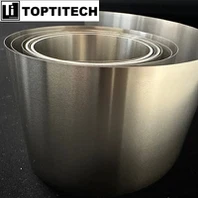Today, TopTiTech is going to introduce 14 cantions about using titanium electrodes.
1. The titanium electrode has a black surface after oxidation and sintering. The uncoated surface is blue and has no electrode performance. The black side corresponds to the cathode.
2. Once the titanium electrode substrate is pickled, all subsequent production and processing procedures and use procedures must be carried out strictly and carefully. When transporting, wear clean gloves to hold the ends or edges of the anode, and it is best to touch the uncoated part. The surface of the coating is strictly prohibited from being scratched by any foreign matter.
Note: The titanium substrate itself is not conductive, and its outer layer is coated with a precious metal oxide coating to have electrocatalytic activity, conductivity, and oxidation resistance, but its thickness is only about 20 microns. During the process, the electrode will first corrode from the damage, which will affect the quality and effect of the entire electrode.

3. The electrolyte should maintain stability, especially not containing cyanide ions and fluoride ions, these impurities will seriously corrode the titanium substrate;
4. Add a filter before the electrolyte enters the electrolytic cell, and it cannot contain metal particles with a diameter greater than 0.1mm, so as to prevent the short circuit of the cathode and anode caused by excessive accumulation.
5. When electrolytic recovery of copper, nickel, gold, silver, cobalt and other metals, the cathode attachment should not be too thick to prevent short-circuit breakdown of the cathode and anode caused by too small electrode spacing or the formation of metal thorns.
6. The distance between the cathode and anode can be set according to actual production, generally 5-25mm. Generally speaking, the pole distance will increase the voltage drop, but it should not be too small, otherwise, the cathode scale generated on the cathode surface will easily cause a short circuit of the plate;
7. Avoid using it with reverse polarity. Once the noble metal oxide coating is used as a cathode, the surface undergoes a reduction reaction and is easily transformed into a simple metal, which cannot be effectively combined with the titanium base, causing the coating to fall off.
8. When shutting down, it is not advisable to soak in the solution in the power-off mode for a long time. It is better to load a small current of about 5A to protect the plate.
9. When shutting down or in other maintenance situations, add dilute acid or clean the surface of the electrode with water, but do not wash it with nylon or mechanical substances.
10. The temperature of the electrolyte should not be too high when it is working. The ideal temperature is 25-40°C. If possible, a heat exchange device can be added to maintain the working environment of the electrode.
11. The normal working current density is within 2000A/m², if the current is too large, the reaction will be too intense and the life of the anode will be shortened;
12. When starting up, load the current to the electrolyzer step by step, do not raise it to the right position at one time, and the same is true when stopping.
13. Keep the anode clean during production and use, and not be contaminated with oil or other attachments, so as not to affect the electrolysis effect and electrode life.
14. The anode has life, and ensuring production stability is more beneficial to prolonging the service life.
Contact
TEL: +8618992731201
FAX: 0917-3873009
EMAIL: zhangjixia@bjygti.com
ADD: 1502, Block A, Chuang Yi Building No. 195, Gaoxin Avenue, High-tech Development Zone, Baoji City, Shaanxi, China




